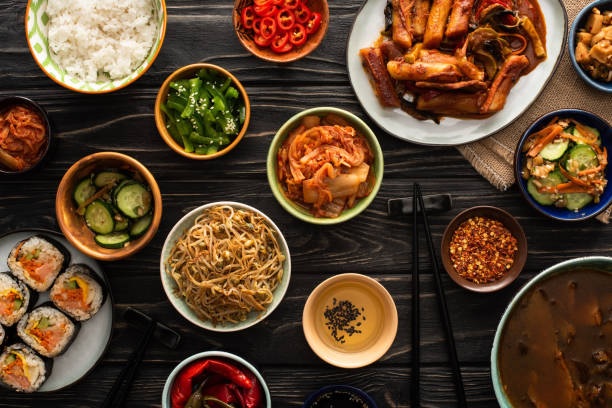Korean cuisine, with its enigmatic blend of tantalizing flavors, captivating history, and a profound reverence for pristine ingredients, has carved a distinctive niche on the global culinary stage. To decipher this intricate tapestry of tastes, joining a Korean food cooking class becomes the key. In this article, we will venture into the world of Korean gastronomy and unearth the treasures concealed within these cooking classes while embracing the perplexity and burstiness of this fascinating culinary journey.
Delving into a Korean Food Cooking Class
A Korean food cooking class offers an immersive portal into the captivating realm of Korean gastronomy. It’s an opportunity to not just learn recipes but to unravel the culture, history, and techniques behind these mouthwatering dishes. Let’s delve into the key facets of this best korean food cooking class in Singapore, embracing the perplexity and burstiness it presents:
Sage Guidance: Skilled chefs and passionate home cooks often serve as instructors in these classes. Their expertise ensures you receive invaluable insights into both the traditional and contemporary facets of Korean cuisine.
Hands-On Discovery: These classes offer more than just a seat at the table. They encourage active participation, allowing you to roll up your sleeves and dive into the preparation process. Hands-on learning fosters a profound understanding of ingredients and techniques.
Market Adventures: Korean markets are treasure troves, teeming with exotic ingredients. If you’re interested in exploring the flavors of Korea, consider taking cooking classes that often include guided trips to these bustling hubs, illuminating the mystery behind quintessential Korean components and their diverse applications. Additionally, for those looking for convenience, you can also buy fish jerky online to savor Korean-inspired flavors from the comfort of your home.
Traditional vs. Modern: The evolution of Korean cuisine is a mesmerizing journey from tradition to modernity. Cooking classes frequently showcase a blend of both, enabling you to appreciate how Korean food has evolved over centuries.
The Joy of Sharing: Korean cuisine is inherently communal. Cooking classes often culminate in a shared meal, allowing participants to savor the fruits of their labor together, forming bonds and a sense of belonging.
The Enigmatic Allure of Korean Cuisine
Korean culinary prowess is an enigma defined by an intricate blend of tradition and innovation. The cuisine’s multifaceted nature, featuring the fiery pungency of Kimchi, the soothing comfort of Bibimbap, and a symphony of other flavors, encapsulates the quintessence of Korean culture. The characteristics that imbue Korean cuisine with its allure include:
Fermented Marvels: The culinary world’s fascination with Korean fare stems from its reliance on fermented treasures like Kimchi, Gochujang (red chili paste), and Doenjang (fermented soybean paste), which bestow complexity and depth upon every dish.
Nature’s Bounty: Korean cuisine venerates seasonal ingredients, ensuring an ever-evolving palette of fresh and vibrant flavors that dance through the seasons.
Banchan: A Hidden Gem: No Korean meal is complete without the enigmatic allure of banchan – an array of tantalizing side dishes that accompany the main course, elevating the dining experience.
The Harmony of Tastes: Korean culinary artistry thrives on the harmony of sweet, salty, spicy, and umami flavors, creating an unparalleled sensory symphony.
A Gastronomic Haven: Many Korean dishes embody the essence of health-conscious dining, championing vegetables, lean proteins, and minimal use of oils, contributing to both flavor and well-being.
Popular Korean Delights in Cooking Classes
While Korean cuisine offers a galaxy of dishes, cooking classes often spotlight a selection of beloved classics that are not only delicious but also accessible for aspiring home chefs. Here are a few examples:
Bibimbap: An artful masterpiece, Bibimbap features a riot of colors and flavors, with vegetables, marinated meats, and a zesty gochujang sauce artfully arranged atop a bed of rice.
Kimchi: The heart and soul of Korean cuisine, learning to craft traditional Napa cabbage kimchi and its radish counterpart is an intriguing journey into the world of fermentation.
Bulgogi: The sizzle of marinated and grilled beef or pork in Bulgogi is a symphony of sweet and savory notes, making it a favorite at Korean barbecue gatherings.
Japchae: These translucent glass noodles, stir-fried with an array of crisp vegetables and bathed in soy sauce and sesame oil, entice with a symphony of textures and flavors.
Tteokbokki: A street food sensation, tteokbokki’s chewy rice cakes bathed in a spicy gochujang sauce elevate snacking to an art form.
Conclusion
Embracing the profound essence of Korean cuisine through a cooking class transcends the mere mastery of recipes; it’s a journey into the heart of a cultural treasure. These classes decode the complexity and diversity of Korean flavors, fostering a sense of community among enthusiasts. They empower you with the skills to recreate these enchanting dishes in your own kitchen. Whether you are an apprentice cook or a seasoned culinarian, a Korean food cooking class promises an odyssey into the mystical world of Korean gastronomy. So, don your apron, grasp your chopsticks, and prepare for a tantalizing adventure that will leave your taste buds yearning for more of the enigmatic wonders of Korean cuisine.
